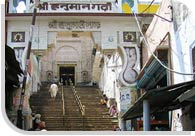Agra Tour

Varanasi Tour

Fatehpur Sikri Tour

Fairs and Festivals

Mathura Tour


 Ayodhya- One of the Seven Sacred Hindu Cities
Ayodhya- One of the Seven Sacred Hindu Cities
The word 'Ayodhya' originated from Sanskrit, and literally means- 'the city that cannot be subdued by war'. Being the birth place of Lord Rama, the seventh incarnation of lord Vishnu, Ayodhya is known for its Hindu Temples. The city is situated on the right bank of River Saryu (6 km north of Faizabad and 135 km northeast of Lucknow) in Uttar Pradesh. Earlier known as 'Kosaldesha', Ayodhya is believed to be founded by Manu, the lawgiver of the Hindus. It was the capital of the Surya dynasty, of which lord Rama was the most renowned king. Therefore, this city of temples has close association with the epic Ramayana. The story of Lord Rama provides the examples of piety, dignity, love, brotherhood, chastity and forgiveness.
Ayodhya is also considered the birth place of five Jain Teerthankars, and some remnants of Buddhism, Hinduism, Islam, and Jainism can easily be found here. Recent archaeological studies reveal that several religions have grown and prospered here. Ayodhya welcomes the pilgrims and tourists throughout the year, but the months from October to March are considered the best season. Tourists should avoid the summer season, i.e. April-June.
Hanuman Garhi
Basically a cave temple, Hanuman Grahi is dedicated to Lord Hanuman. The temple is one of the most popular religious shrines in Ayodhya and is also visited for its impressive structure and wonderful architectural skills. After reaching the temple by a flight of 76 steps, one finds a statue of Goddess Anjana (Hanuman's mother), with Bal Hanuman seated on her lap. People believe that it is the same place where Lord Hanuman lived and guarded Ramkot or Janmabhoomi. The land for the temple was donated by the Nawab of Avadh. And when the temple was constructed around the middle of the 10th century, it was designed in the shape of a four sided fort with circular bastions at each corner.
Jain Shrines Ayodhya
Along with Hinduism, Ayodhya is known for Jain religious values also. It is known as the birth place for five Jain Tirthankars who preached the Jain religious values. The major Jain shrines or temples in Ayodhya are:
-Ratanpuri (to the west of Ayodhya, near Ronahi. Birth place of Lord Dharamnath)
-Swargdwar (associated with the memories of the first Tirthankara, Lord Vrishabhnath. He is also revered as Adinath, Purdev and Adi-Brahma.)
-Baksaria Tola (Birth place of Lord Ajitnath)
-Ramkot Muhalla Rajghat (Birth place of Lord Abhinandan Nath. Also the birth place of Lord Anantnath)
-Raiganj (known for the Digambar Jain Temple and giant idol of Lord Vrishabhdev)
The shrines host all the Jain festivals and holy occasions and draw thousands of devotees and tourists from all over the world.
Kanak Bhawan
The word 'Kanak Bhawan' literally means - House of Gold in Hindi/Sanskrit. Situated near Hanuman Garhi, Kanak Bhawan Temple is known for the beautiful idols of Lord Rama and Goddess Sita, wearing gold crowns. The idols are decorated with heavy gold ornaments. According to legends, the temple was built by Lord Rama's stepmother, Rani Kaikeyi for Sita. Contrary to this, local people say that it was constructed by Rani Krishnabhanu Kunwari of Orccha in 1891.
Nageshwarnath Temple
Situated amidst numerous 'Matths' and 'Akhadas', the Nageshwarnath Temple (Shiva Temple) is one of the most frequented temples in Ayodhya. It was the temple that helped Vikramaditya to locate Ayodhya and the sites of several other shrines here. The temple, famous for its designs and wonderful architecture of the Surya dynasty, is believed to have been built by Raja Kush, the younger son of Lord Rama. As the story goes, Raja Kush once lost his armlet while bathing in River Saryu. The armlet was picked up by a Nag-Kanya (Snake-damsel) who fell in love with him. As the Nag-Kanya was a devotee of Lord Shiva, Kush erected this temple for her. The temple attracts thousands of people during �the festival of Shivaratri, which is celebrated with great zeal.
Ramkot
Situated on the western part of Ayodhya, Ramkot Citadel is one of the most frequented religious sites. People believe that the fort of Lord Rama once existed on this site and Hunuman used to guard this citadel from a secret cave (Hanuman Garhi of the present day). Ram Navmi, the birthday of Lord Rama, in the Hindu month of Chaitra (March-April), is celebrated with full vigor and enthusiasm at Ramkot.
The nearest airports from Ayodhya are Amausi in Lucknow (134 km) and Babatpur in Varanasi (209 km). Besides, the city is situated on the Northern Railway line on the Mughal Sarai-Lucknow route. It is also connected to Lucknow (134 km), Gorakhpur (132 km), Jhansi (441 km), Allahabad (166 km), Sravasti (109 km), Varanasi (209 km) and Gonda (51 km) via road.
 Classical North India
Classical North India Classical North India+Nepal
Classical North India+Nepal Buddhist Pilgrimage Tour
Buddhist Pilgrimage Tour Rajasthan with Classical India & Kathmandu
Rajasthan with Classical India & Kathmandu